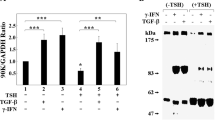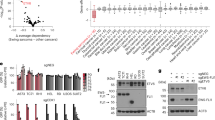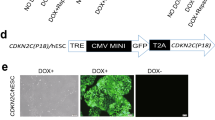Abstract
We found that human melanoma SEKI and neuroepithelioma NAGAI cells, which are known to secrete high concentrations of leukemia inhibitory factor (LIF), also secrete high levels of hepatocyte growth factor (HGF). We therefore examined the role of LIF in HGF expression and examined the human HGF promoter. The expression of both LIF and HGF mRNA is very low in HEK293 cells. Treatment of these cells with LIF stimulated the expression of HGF mRNA. The cis-acting regulatory element of the HGF promoter in SEKI and 293 cells was analysed by means of a transient expression assay. By deletion analysis, we showed that the region comprising the −181 to −73 bp was required for full activity of the HGF promoter in SEKI cells and for LIF responsiveness of 293 cells. This region contains putative consensus sequences for the Stat and NF-IL6 (C/EBP β) transcription factors. The activity of the HGF promoter was abolished by mutation of the Stat site at −99/−91, while the activity only slightly decreased on mutation of the NF-IL6 site. Treatment with anti-LIF antibodies or interruption of Stat3 signaling by dominant-negative Stat3 also reduced the HGF promoter activity. Stat3 activation was constitutive in SEKI cells and induced on treatment of 293 cells with LIF. These results suggest that cytokines, growth factors and oncogenes (v-Src, etc.) that activate Stat3 are important regulators of HGF expression.
This is a preview of subscription content, access via your institution
Access options
Subscribe to this journal
Receive 50 print issues and online access
$259.00 per year
only $5.18 per issue
Buy this article
- Purchase on Springer Link
- Instant access to full article PDF
Prices may be subject to local taxes which are calculated during checkout







Similar content being viewed by others
References
Akira S, Isshiki H, Sugita T, Tanabe O, Kinoshita S, Nishio Y, Nakajima T, Hirano T and Kishimoto T . (1990). EMBO J., 9, 1897–1906.
Akira S, Nishio Y, Inoue M, Wang XJ, Wei S, Matsusaka T, Yoshida K, Sudo T, Naruto M and Kishimoto T . (1994). Cell, 77, 63–71.
Auernhammer CJ and Melmed S . (2000). Endocr. Rev., 21, 313–345.
Barasch J, Yang J, Ware CB, Taga T, Yoshida K, Erdjument-Bromage H, Tempst P, Parravicini E, Malach S, Aranoff T and Oliver JA . (1999). Cell, 99, 377–386.
Bowman T, Garcia R, Turkson J and Jove R . (2000). Oncogene, 19, 2474–2488.
Bromberg J . (2002). J. Clin. Invest., 109, 1139–1142.
Ehret GB, Reichenbach P, Schindler U, Horvath CM, Fritz S, Nabholz M and Bucher P . (2001). J. Biol. Chem., 276, 6675–6688.
Horvath CM, Wen Z and Darnell Jr JE . (1995). Genes Dev., 15, 984–994.
Hung W and Elliott B . (2001). J. Biol. Chem., 276, 12395–12403.
Iseki H, Kajimura N, Ohue C, Tanaka R, Akiyama Y and Yamaguchi K . (1995). Jpn. J. Cancer Res., 86, 562–567.
Jiang JG and Zarnegar R . (1997). Mol. Cell. Biol., 17, 5758–5770.
Kamohara H, Sakamoto K, Ishiko T, Mita S, Masuda Y, Abe T and Ogawa M . (1994). Res. Commun. Mol. Pathol. Pharmacol., 85, 131–140.
Li M, Sendtner M and Smith A . (1995). Nature, 378, 724–727.
Liu Y, Michalopoulos GK and Zarnegar R . (1994). J. Biol. Chem., 269, 4152–4160.
Lowe DG, Nunes W, Bombara M, McCabe S, Ranges GE, Henzel W, Tomida M, Yamamoto-Yamaguchi Y, Hozumi M and Goeddel DV . (1989). DNA, 8, 351–359.
Maina F and Klein R . (1999). Nat. Neurosci., 2, 213–217.
Matsumoto K and Nakamura T . (1996). J. Biochem. (Tokyo), 119, 591–600.
Miyazawa K, Kitamura A and Kitamura N . (1991). Biochemistry, 30, 9170–9176.
Nakamura T, Matsumoto K, Kiritoshi A, Tano Y and Nakamura T . (1997). Cancer Res., 57, 3305–3313.
Nakamura T, Nawa K and Ichihara A . (1984). Biochem. Biophys. Res. Commun., 122, 1450–1459.
Niu G, Wright KL, Huang M, Song L, Haura E, Turkson J, Zhang S, Wang T, Sinibaldi D, Coppola D, Heller R, Ellis LM, Karras J, Bromberg J, Pardoll D, Jove R and Yu H . (2002). Oncogene, 21, 2000–2008.
O'Farrell AM, Liu Y, Moore KW and Mui AL . (1998). EMBO J., 17, 1006–1018.
Santos OF, Barros EJ, Yang XM, Matsumoto K, Nakamura T, Park M and Nigam SK . (1994). Dev. Biol., 163, 525–529.
Schmelzer CH, Harris RJ, Butler D, Yedinak CM, Wagner KL and Burton LE . (1993). Arch. Biochem. Biophys., 302, 484–489.
Schmidt C, Bladt F, Goedecke S, Brinkmann V, Zschiesche W, Sharpe M, Gherardi E and Birchmeier C . (1995). Nature, 373, 699–702.
Seidel HM, Milocco LH, Lamb P, Darnell Jr JE, Stein RB and Rosen J . (1995). Proc. Natl. Acad. Sci. USA, 92, 3041–3045.
Tamura M, Arakaki N, Tsubouchi H, Takada H and Daikuhara Y . (1993). J. Biol. Chem., 268, 8140–8145.
Tomida M, Yamamoto-Yamaguchi Y and Hozumi M . (1984). FEES Lett., 178, 291–296.
Tomida M, Yamamoto-Yamaguchi Y, Hozumi M, Holmes W, Lowe DG and Goeddel DV . (1990). FEES Lett., 268, 261–264.
Tomida M, Heike T and Yokota T . (1999). Blood, 93, 934–941.
Uehara Y, Minowa O, Mori C, Shiota K, Kuno J, Noda T and Kitamura N . (1995). Nature, 373, 702–705.
Wagner BJ, Hayes TE, Hoban CJ and Cochran BH . (1990). EMBO J., 9, 4477–4484.
Ware CB, Horowitz MC, Renshaw BR, Hunt JS, Liggitt D, Koblar SA, Gliniak BC, McKenna HJ, Papayannopoulou T, Thoma B, Cheng L, Donovan PJ, Peschon JJ, Bartlett PF, Willis CR, Wright BD, Carpenter MK, Davison BL and Gearing DP . (1995). Development, 121, 1283–1299.
Weidner KM, Arakaki N, Hartmann G, Vandekerckhove J, Weingart S, Rieder H, Fonatsch C, Tsubouchi H, Hishida T, Daikuhara Y and Birchmeier W . (1991). Proc. Natl. Acad. Sci. USA, 88, 7001–7005.
Woolf AS, Kolatsi-Joannou M, Hardman P, Andermarcher E, Moorby C, Fine LG, Jat PS, Noble MD and Gherardi E . (1995). J. Cell Biol., 128, 171–184.
Yu CL, Meyer DJ, Campbell GS, Larner AC, Carter-Su C, Schwartz J and Jove R . (1995). Science, 269, 81–83.
Zhong Z, Wen Z and Darnell Jr JE . (1994). Science, 264, 95–98.
Acknowledgements
We wish to thank Dr Takashi Yokota, Graduate School of Medical Science, Kanazawa University, for providing the dominant-negative Stat3B construct. This work was supported in part by the Project, Saitama Prefecture Collaboration of Regional Entities for the Advancement of Technological Excellence, JST.
Author information
Authors and Affiliations
Corresponding author
Rights and permissions
About this article
Cite this article
Tomida, M., Saito, T. The human hepatocyte growth factor (HGF) gene is transcriptionally activated by leukemia inhibitory factor through the Stat binding element. Oncogene 23, 679–686 (2004). https://doi.org/10.1038/sj.onc.1207190
Received:
Revised:
Accepted:
Published:
Issue Date:
DOI: https://doi.org/10.1038/sj.onc.1207190
Keywords
This article is cited by
-
Selective visuoconstructional impairment following mild COVID-19 with inflammatory and neuroimaging correlation findings
Molecular Psychiatry (2023)
-
Universal direct PCR amplification system: a time- and cost-effective tool for high-throughput applications
3 Biotech (2017)
-
Characteristics of Cardiac Cell Cultures Derived from Human Myocardial Explants
Bulletin of Experimental Biology and Medicine (2013)
-
Stat3 up-regulates expression of nicotinamide N-methyltransferase in human cancer cells
Journal of Cancer Research and Clinical Oncology (2008)
-
A novel activating function of c-Src and Stat3 on HGF transcription in mammary carcinoma cells
Oncogene (2006)



